

EVERY one of the aviation machines shown in the accompanying illustrations is dear to its maker or designer and to his friends. Every one of them has something in its construction which is promising, sensible or brilliant to men whose ability in the ordinary walks of life has been sufficient to enable them to save or borrow the money wherewith to substantially their faith in aviation. All but one are proudly photographed ready to fly at the word "go." Yet only the one not so pictured ever made a start. The others probably still cherish the convictions which created them by means of occult or theoretical qualities, the nature of which the uninitiated beholder may only surmise. Here is a problem for the psychologist to solve. Mechanics alone scarcely furnish the key to its correct solution. The shrewd observation that it is better to get into the "game of aviation" wrong than not to get into it at all in its beginning may have shaped many of the hasty creations which abound in the shops of amateur aviators the world over. They are evidence of a widespread desire to become identified at almost any cost with a movement clearly destined to be more conspicuously picturesque in its unfolding than any other which civilization has ever witnessed, and prodigiously fruitful in physical, scientific and financial adventure. These odd structures are claims staked off on the hills of golden promise, and the cheerful prospectors confidently expect to "grow up with the country," and to reap the rewards which come to all sturdy' pioneers. A single unproportioned thought, "given his act" contrary to the advice of Polonius and embodied in steel, wood and fabric, is boldly offered as the entry fee, and lo! the world generously accepts it. For is it not after all proof of courage and energy, those primary traits of character which are as much needed for progress as mere insight, which grows with what it feeds upon and may be acquired. These men shall have free passes to glory and advancement, provided they stand by their claims, work them and guide their next steps a little more closely to the sum total of dry facts and experiences from which real flying aeroplanes have been evolved
The unproportioned thoughts manifested in the various machines are not without interest. The edgewise tumble has haunted the maker of No. 1. Of this he is sure: So long as the motor and propeller are kept working, these drums will uphold whatever they are capable of upholding, whether the wind tosses them to one side or the other. Pivoted as they are to the elegant trussed frame, they afford means for sustentation, for steering and for fore-and-aft balancing, all combined in a single mechanical conception. If the propellers cease propelling, simply tilt both drums forward for a gradual descent. Should the impact with the earth be a little hard, the structure offers the same advantage which has served Latham so well in his Antoinette flier; namely, that there is much material to be broken before the shock reaches the aviator's person. It seems almost a pity that the laws of the atmosphere will not permit drums to act as efficient aeroplane lifters.
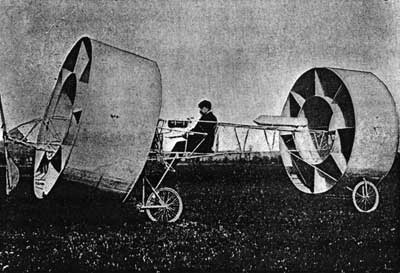
Fig. 1.This
designer was haunted by the fear of edgewise tumbling. He did not know that
drums are inefficient lifting surfaces.
The machine shown in Fig. 2 is the contribution of the Marquis d'Equeuvillay. It may be imagined that the scion of a noble house has started his train of thought with a profound respect for the magic strength of a bicycle wheel. By developing its great principle of centripetal stresses it should be possible to produce a very light framework rich in capacity for areas, strong and yet deformable at its ovalized periphery, and, Eureka! with motor and aviator centrally located and applying the vital forces of propulsion and control from the rigid hub, the very deformation of the rim and planes might be utilized for steering and balancing. Note also the forethought evinced in shaping the upper planes with a self righting curvature.
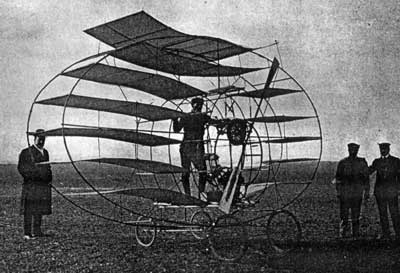
Fig. 2.A marqui's
idea of applying the principle of centripetal stresses. Too much head
resistance here.
If two planes are better than one, then three planes are better than two. This is the simple and powerful idea embodied in the apparatus pictured in Fig 3, and which is known as the Bousson-Bourgnis. It is common to many triplanes. In addition. an abundance of rudders, generous in size, and a certain flabby flexibility in all the areas, testify to an active, energetic misunderstanding of nearly all the leading principles in successful aviation. The head-on resistance is enormous. What might perhaps have been gained by using perfectly elastic materials shaped and proportioned so as to return an equivalent in work for the power expended in bending the planes back, is squandered through the acceptance instead of unresponsive materials, endowed with an inert flexibility rather than resiliency, the bending of which, under the influence of air resistance, means mainly the generation of heat from molecular friction and the consequent wasting of the power employed for overcoming the air resistance.
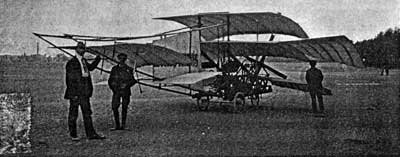
Fig. 3.If two
planes are better than one, three must be better than two, argued this
designer, taking no account of the head resistance.
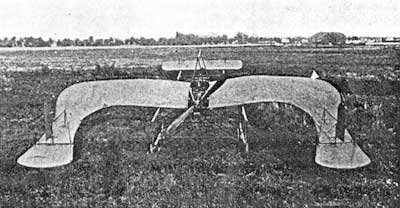
Fig. 4.Here the eye rests in peace,
for compared with standard designs the variations are more conspicuous
than radical.
Stoeckel's monoplane (Fig. 6 in this series) was expected to work a revolution in aeroplane dynamics, for it is equipped with a motor of only twelve horsepower driving two propellers of very modest diameters located far below the level of the planes and the bulk of the air resistance. Under these circumstances the machine should immediately tip over backward the moment the wheels leave the ground, but the designer has placed an inverted canoe, also useful as a sunshade, lengthwise over the central portion of his machine, and in this device he must have anticipated special virtues, not only the feeble merits of an undersized parachute, but something extraordinary in the way of balancing effect, since it is otherwise an axiom among aeroplane builders that the power and the air resistance must be kept pretty well in line. As a wind wagon skipping nimbly over the aviation field the compact Stoecker, with its short wheelbase, should have real merit, however, not to be despised for meets, particularly if the inverted canoe, as the illustration suggests, may be tipped and utilized to preserve the balance.

Fig. 5.Here is a
huge machine which seems to have been designed by one who admired the
sweeping curves of copybook penmanship.
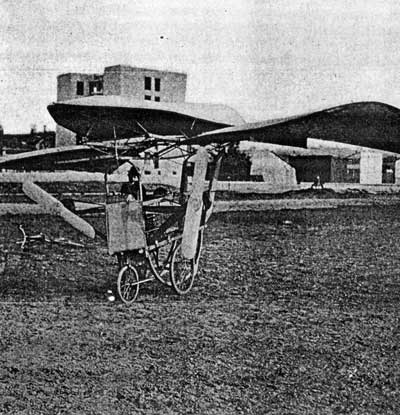
Fig. 6.A monoplane that was expected
to "revolutionize" aerodynamics and didn't.
The largest aeroplane in the world is shown in Fig. 5. It was constructed at Dunstall, near Wolverhampton, by Lieut. Seddon of the British navy. It is equipped with two 80 horse-power engines and its planes measure an area of 1,000 square feet. The boldness of the figures and of the mechanical execution, with the great hoops and sweeping curves suggesting the expert in Spencerian handwriting, almost disarms criticism, numbing it with the query: Can this be possible? Can this be what we are striving for and what we are coming to? In that case, would it not be better to leave aviation alone until a more advanced mastery of materials shall have made it possible to accomplish it by simpler designs? The large hoops, crossed with others like them and tied at the crossings, give great freedom in producing any desired relation between the planes. By mere changes in the angles and the points of contact of the hoops, practically the same framework may be utilized for a number of experimental variations, and perhaps it may be assumed that the designer has been actuated by this consideration, knowing that the tandem arrangement of planes has been found unfavorable to equilibrium, but knowing also that no large aeroplane construction can be expected until this difficulty shall have been experimentally overcome. But the design looks more theoretical than inspired.
The engineer responsible for the example in Fig. 7 has also tackled elongated construction, being plainly actuated by hopes of escaping from the problem of lateral equilibrium. As for the necessary sustentation, fancy this scow being sucked forward through the atmosphere at great speed by the innocent little propeller, and the friendly mind will readily perceive how the bow will throw powerful air waves upward against the flying-fox membrane extending from the gunwale, fairly lifting the structure; and, moreover, the hollow of the scow will create a vacuum-the vacuum being a highly favored phenomenon among independent aeroplane designers, nearly always produced without special expenditure of power-to fill which a mighty upward pressure from the atmosphere underneath will automatically assert itself. The hand wheel in front of the operator seems to connect with a simple rudder at the top for side steering, and the perfect lateral balance produced by the narrow conformation and the low center of gravity (really permissible with this shape) should render all other and auxiliary steering means superfluous. For up-and-down steering perhaps the aviator slides his own weight forward and backward.

Fig. 7.Fancy this
scow being sucked forward through the atmosphere at great speed by the
innocent little propeller!
The seven machines mentioned and illustrated in the foregoing might have been proposed and built whether Lilienthal, Maxim, Langley, the Wrights and Bleriot had ever gathered data for aviation or not. But on the Diapason monoplane (Fig. 4) the eye may rest in peace. As compared with standard design, its variations are more conspicuous than radical. The tail and side-steering apparatus have been cut in twain and moved to the two sides; the ailerons have been moved rearward. The arrangement makes room for a large propeller, and, while the equilibrium seems more sensitive, the means for maintaining it and for steering may at the same time have been improved. The machine is said to have flown with some success, and it would be rash to assert its superiority or inferiority in comparison with other models depending on control by rudder action. It accentuates this feature, making even stronger demands upon the aviator's agility than the standard type.
During the past month there have been many accidents. In several of these the aeroplane has caught fire in the air, and the aviator has been burned to death or killed by the fall. One such accident occurred in France on September 2nd, another in Spain two days later, and the third, in which two men were killed, happened in Germany on the 7th ult. Maron, the French pilot of the Savary biplane, was the first victim of this type of accident. He experienced a bad fall on the 2nd ult. His machine caught fire, and when it struck the ground, he was incinerated under the debris. Lieut. de Grailly, of the French army, also fell and was burned to death on the 2nd inst., owing, it is claimed, to the breaking of a wing of his R. E. P. monoplane. Capt. Camine, with 'he same make of machine, was killed by the fall due to the same cause. On September 5th, M. Leforestier, a French aviator, fell to his death at Huelva, Spain. His machine, which was of his own construction, is said to have caught fire in the air.
Two other men who were victims of this kind of accident were Lieut. Newmann, a German military aviator, and M. Leconte, his passenger. While making a cross-country flight on September 7th the machine caught fire when at a height of sixty feet, and fell to the ground, instantly killing both aviators. The same day, Paul Senge, another German aviator, fell and fractured his skull at the town of Karlsruhe Two days later Herr Eyring was killed near Stuttgart. On September 29th, Capt. Englehardt, Germany's premier military pilot and the first man whom the Wrights taught to fly in that country, was killed by a fall, while his passenger, Herr Sedlmayer, had his skull fractured and received other serious injuries.
In England, Lieut. Cammell, a seasoned Bleriot pilot, on the 18th ult., fell to his death while making his first flight in a Valkyrie (English) monoplane. He had been aloft 10 minutes and was making his second wide circuit, when the monoplane turned over and dropped 90 feet to the ground. Capt, J. J. Frisbie, Louis Rosenbaum and Cromwell Dixon were killed in America when flying at State fairs. The last-named aviator, a youth of but 19, fell 80 feet into a stone quarry at Spokane, Wash., on October 2nd, owing to his turning too sharply to avoid hitting some telegraph wires, and sliding down on end as a consequence. A few days before, at Helena, Mont., Dixon had flown over the Rocky Mountains to Blossburg, a small town 18 miles away, and back again. Blossburg lies in a deep pocket in the mountains, from which wild ducks and geese escape with difficulty after battling with the air currents sometimes for hours. It took Dixon twice as long 22 minutesto attain the necessary altitude of 7,000 feet at Blossburg as it did at Helena. The trip out and back across the 6,200-foot Mullins Pass was made in 15 and 17 minutes respectively. Dixon was given a $10,000 purse made up by several men who witnessed his flight. He delivered a letter from Governor Norris. This is the second time a Curtiss biplane has crossed the Rockies. Ely was the first to accomplish this feat at Butte, Mont., last spring.
On September 25th, at the Nassau Boulevard meet, Dr. Clark, a trick bicyclist, had a fatal fall in a Queen monoplane. He was unable to accustom himself to moving the warping control lever outward instead of inward when turning. A sharp turn to the right, caused by improper warping, resulted in the instant development of gyroscopic force by the revolving motor sufficient to make the machine dive vertically to the ground.
Originally appeared in Scientific American, 105, October 14, 1911, pp. 338-339.
sbck/htgb